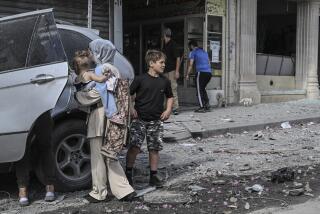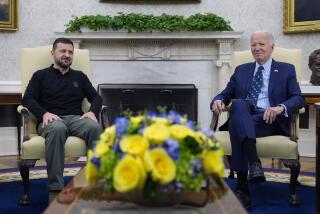U.S. Study of War on Yugoslavia Aimed at Boosting Performance
- Share via
WASHINGTON — The Pentagon has launched a major review of the war against Yugoslavia in an effort to improve the military’s future performance, as well as to protect the legacy of what U.S. officials insist was history’s most successful air campaign.
While Pentagon officials portray the problems encountered during NATO’s 11-week air war as mostly minor, they acknowledge that the six-week study must wrestle with several issues that continue to stir controversy here and in Europe.
Among the questions:
* Why did NATO officials substantially overestimate how much Yugoslav military hardware their warplanes hit?
* Why did it take so much equipment--and time--to suppress a 30-year-old air defense network?
* And, in an era when the West increasingly views war as a coalition effort, did NATO’s cautious group decision-making hobble the campaign or, by preserving unity, guide it to its successful conclusion? Pentagon officials have signaled that they don’t intend to lose control of the study’s agenda to the war’s critics in Congress or doubters in the press.
“Our review is about how we fought, I thought, a very good operation,” Deputy Defense Secretary John Hamre said. “I think the troops did a terrific job.”
One key observer likely hopes that the study won’t be too downbeat. President Clinton has indicated to associates that he believes he has been denied full public credit for what the White House views as an unqualified success.
Yet some people in Congress say that if the Pentagon review doesn’t produce the answers they want, they may later commission an independent analysis, as was done after the Persian Gulf War.
Questions about the extent of damage inflicted by NATO forces on the Yugoslav military may produce the most heat. The issue has generated controversy in a number of alliance countries, such as Britain, where Conservative Party lawmakers have pushed for a formal study.
At the end of the war, North Atlantic Treaty Organization officials claimed that their forces had disabled 150 of the estimated 400 Yugoslav tanks stationed in Kosovo. But Army Gen. Wesley K. Clark, NATO’s supreme commander in Europe, has since scaled the official estimate back to 110 disabled, and Pentagon officials say they won’t hazard a guess until NATO officials get a chance to thoroughly study evidence in the province.
It is clear, however, that many of tanks supposedly damaged were decoys made of wood and draped with plastic sheeting. In some cases, observers have reported finding pans of water set inside. Yugoslav soldiers apparently discovered that as the water warmed in the sun it helped the decoy duplicate a real tank’s heat “signature,” fooling NATO infrared detection devices.
Humanitarian workers and reporters have found the decoy tanks in many places in the province, along with fake mortar emplacements and bridges that Yugoslav forces hoped would divert NATO missiles from real targets.
Some U.S. defense officials have argued that the performance issue is not critical. However slight the damage, they say, Yugoslav President Slobodan Milosevic ultimately signed a peace deal.
But some outside analysts argue that the extent of damage is key because of what it tells policymakers about the effectiveness of a war that, to minimize NATO casualties, was conducted mostly from high altitudes.
“It’s a very fundamental issue,” said Eliot A. Cohen, a professor at Johns Hopkins’ Nitze School of Advanced International Studies who analyzed the Persian Gulf War for the Air Force. “You have to know the consequences of flying high.”
Another key tactical question is how the West can improve its effectiveness against air defense systems such as those operated by the Serbs. The Yugoslav system brought down only two U.S. planes while launching about 700 surface-to-air missiles and prodigious artillery fire; yet it remained largely hidden and survived well enough to keep NATO planes at a distance.
Military officials and outside analysts said there probably is no single weapon or technology that can make NATO more effective in bashing air defenses.
Instead, they said the answer probably lies in getting more and better information about enemy forces in the field and finding ways to quickly get the data to pilots and ground weapons to root out mobile enemy missiles and radars. These are the kind of improvements the military has been pursuing for decades, experts noted.
Meanwhile, there are likely to be sharp internal disagreements on other issues in the report.
Many officers with other services believe that the Army’s deployment of Apache AH-64 helicopters and accompanying troops and missile launchers in Task Force Hawk proceeded far too slowly, and point to the need for major logistics improvements.
But some top Army officials contend that the effort was executed smoothly and was hampered only by weather and the difficulty of moving materiel through the Tirana, Albania, airport amid a massive humanitarian relief effort.
Cohen of Johns Hopkins said it will be difficult for the Pentagon to offer a fully candid review of its own performance, given the institutional pressures to avoid embarrassment and preserve secrecy.
“It’s very hard for a study to be comprehensive, brutally candid and unclassified,” he said. “You have to be willing to be embarrassed, at least a little bit.”
More to Read
Sign up for Essential California
The most important California stories and recommendations in your inbox every morning.
You may occasionally receive promotional content from the Los Angeles Times.














